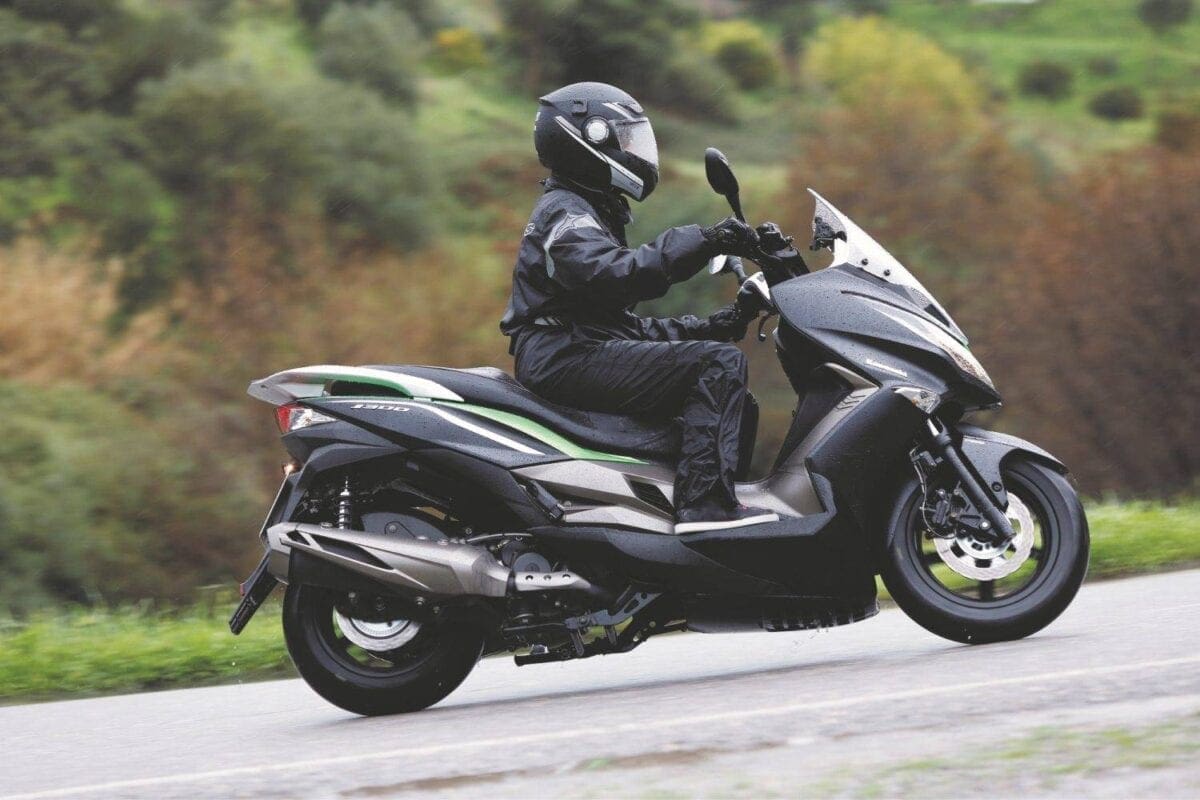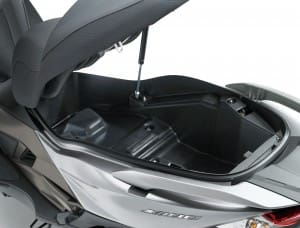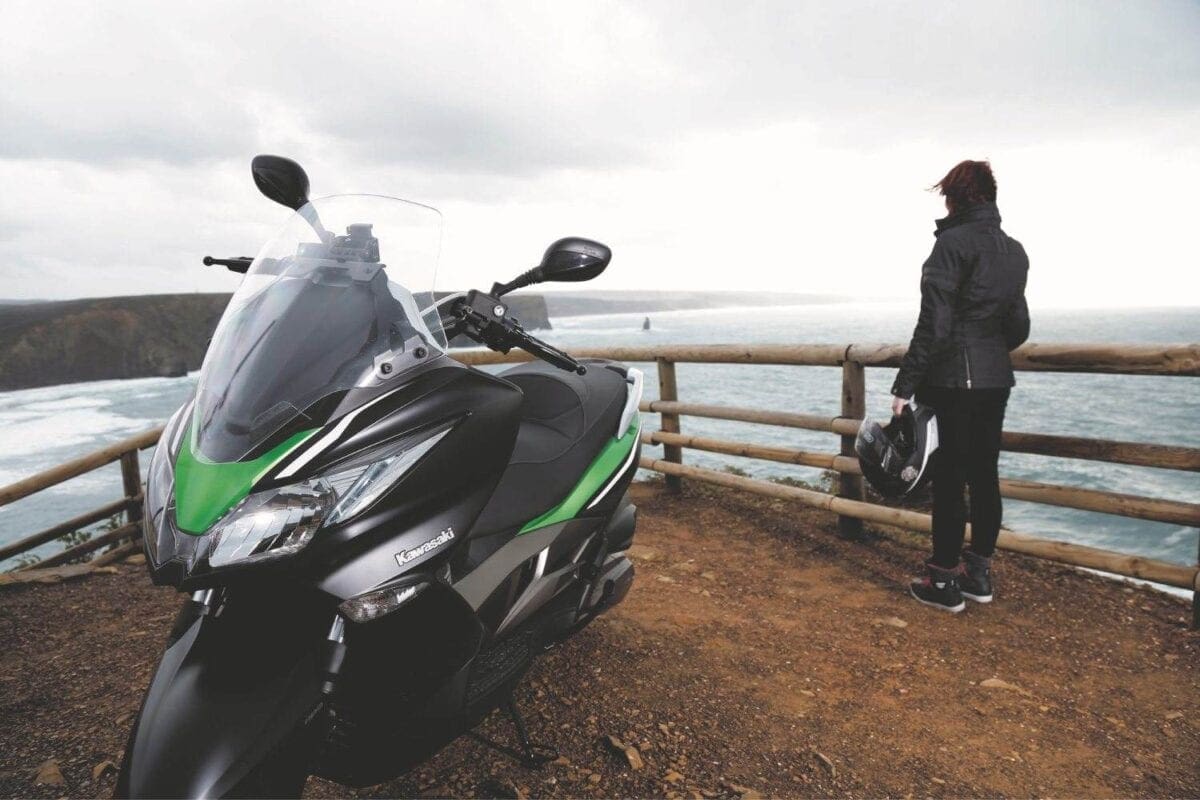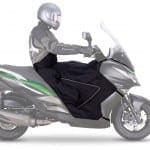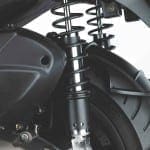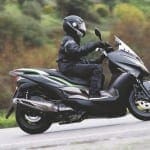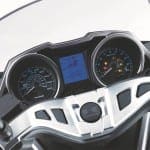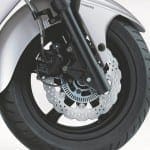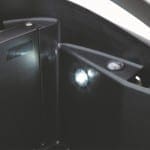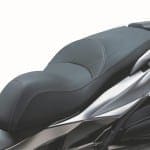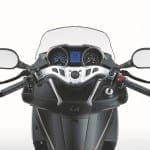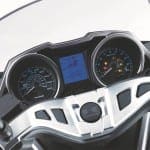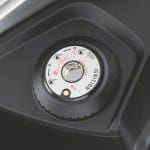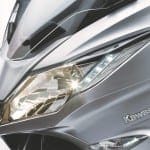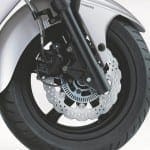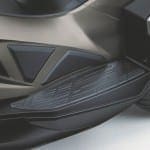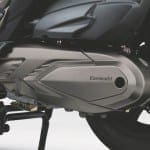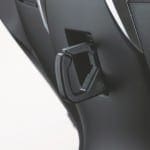£4049 | 299cc |4-stroke Single |liquid-cooled |27.2bhp |21.2lb-ft
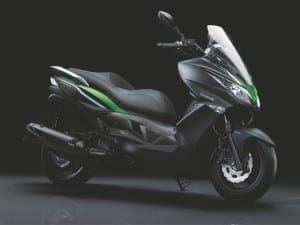 With its angular lines and fierce headlight design, this is clearly a Kawasaki. However, unlike the other machines in the range, the J300 is the company’s first ever scooter for the European market.
With its angular lines and fierce headlight design, this is clearly a Kawasaki. However, unlike the other machines in the range, the J300 is the company’s first ever scooter for the European market.
At the 43rd Tokyo Motorshow in 2013, Kawasaki unveiled their innovative and futuristic ‘J concept’: an imgainiative look into the future, with a strong focus on the environment, personal transport and vehicle efficiency . The J300 is the first step into this long-term vision.
Tell me about the engine
Kawasaki buddied up with Taiwanese manufacturer, KYMCO, to work on the engine and basis of the J300, applying their own variations throughout. The 299cc liquid-cooled motor gives smooth acceleration, thanks to the Continuously Variable Transmission (CVT), while the power delivery is strong, with no sign of struggling, even up steep gradients.
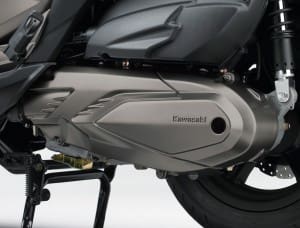 Peak power from the machine is 27.2bhp, which is great for nipping in and out of inner-city traffic, and there’s enough left when you roll open the throttle to overtake in the countryside. Kawasaki wanted the J300 to be economical, but they also wanted it to be fun to ride…. Even cruising along the motorway i a joy, with the scooter remaining strong at 70mph, with more to offer if you want it.
Peak power from the machine is 27.2bhp, which is great for nipping in and out of inner-city traffic, and there’s enough left when you roll open the throttle to overtake in the countryside. Kawasaki wanted the J300 to be economical, but they also wanted it to be fun to ride…. Even cruising along the motorway i a joy, with the scooter remaining strong at 70mph, with more to offer if you want it.
What’s the chassis like?
With a kerb weight of 191kg and seat height of just 775mm, the J300 is no lightweight, but it’s nimble and manageable – even when stationery. The 13 litre fuel tank is located in the floor, which keeps the centre of gravity low, and the 14” front wheel and 13” rear give a motorcycle-like feeling of stability. Combined with the telescopic fork on the front and twin preload-adjustable shocks on the rear, the J300 is a sporty and comfortable ride.
Integrated into the carefully designed lines of the compact back-end is a pillion grab-rail, with the motorcycle-styled footpegs providing a secure platform for passenger’s feet.
 Stopping power is provided by dual petal disc brakes on the front and rear – a 260mm two-piston caliper on the front and a 240mm on the rear. Even in the severe downpour we experienced, they offered strong and controlled braking to bring the scooter to a stop. An ABS version of the scoot will also be available (after talking to me and the other journalists on the press launch in Portugal), costing £350 more than the SE).
Stopping power is provided by dual petal disc brakes on the front and rear – a 260mm two-piston caliper on the front and a 240mm on the rear. Even in the severe downpour we experienced, they offered strong and controlled braking to bring the scooter to a stop. An ABS version of the scoot will also be available (after talking to me and the other journalists on the press launch in Portugal), costing £350 more than the SE).
Should I buy one?
The J300 has been designed and manufactured with commuters in mind – comfortable and economical – without losing sight of the fun in motorcycling. Instead of looking at what other manufacturers do and simply copying, Kawasaki have thought about the problems riders face, and looked to solve them… For instance, we’ve all done it: crammed something under the seat and then pulled up at home in the dark and had to scrabble round looking for it, all whilst balancing the seat on your head. You don’t have to worry about that with the J300: the seat features a hydraulic strut and an LED light to help you to see into the huge storage area, which is big enough for a full-face helmet and A4 briefcase!
 The blue-backlit LCD screen on the dash includes an odometer, dual trip meters, a clock and fuel gauge. Also, unusually for a twist and go, there’s a rev counter – not that vital, but I enjoyed watching the CVT doing its business.
The blue-backlit LCD screen on the dash includes an odometer, dual trip meters, a clock and fuel gauge. Also, unusually for a twist and go, there’s a rev counter – not that vital, but I enjoyed watching the CVT doing its business.
Little touches such as the 12V power socket in the glove box – useful for powering heated gear, charging your phone or plugging in your sat-nav – make this a well thought out machine, while there are a number of accessories available, including two top-box options, a larger windscreen, an accessory mount and an all-weather apron.
Whilst KYMCO were chosen as a ‘strategic partner’, the scooter has Kawasaki’s engineering specification, and a number of changes were made to the machine before the Kawasaki logo made its way into the bodywork, including: headlamps; suspension; screen; heel pads; brake hoses; rider footboards – the list is rather extensive!
The casual and relaxed riding position made even 90miles on the J300 very comfortable. When speaking to motorcyclists, Kawasaki found that they liked to grip the tank with their legs for a feeling of security and control. This was an element they found lacking and slightly unnerving when riding scooters, so heel grips have been incorporated into the footboards. There are also cut-outs to allow you to put your feet down easily. They take a bit of getting used to, but once you remember they’re there, you’re able to get your feet down faster and closer to the bike – good for everyone, especially shorties.
In and around town, especially passing impatient city car drivers, it’s nice to know you have low and mid-range power to enable you to nip through gaps… just a blip of the throttle and you’re off..
When you’re looking to enjoy the roads and get into the twisties, the J300 urges you to have fun, and gives you what you want. Simply rolling on and off the throttle helps control the bike and tip it into the bends with confidence. This is definitely a scooter that could be used for necessity as well as enjoyment.
Tested by: Carli Ann Smith Photos: Double Red
TECH SPEC
Kawasaki J300 (2014)
Price: £4049 (£4149 for the green special edition, £4499 for the SE ABS model)
Engine: 299cc, liquid-cooled, 4-stroke, single cylinder
Power: 27.2bhp (20.3kW) @ 7750rpm
Torque: 21.2lb-ft (28.7Nm) @ 6250rpm
Weight: 191kg
Seat height: 775mm
Tank size: 13 litres
Contact: www.kawasaki.co.uk
More photos…

